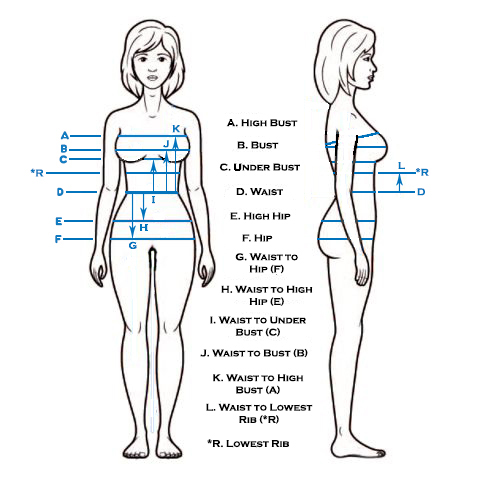Corset Sizing
1. Wrap a piece of ribbon or thread around your waistline. Bend side to side to force the ribbon/thread on to the narrowest point on your torso somewhere between the base of your ribcage and your belly button.
2. Tie the ribbon/thread. This is your natural waistline.
3. Measure and record your waist circumference.
4. ***Lowest Rib Circumference – This measurement should be taken at the height of the lowest part of your rib cage. To find the bottom of your rib cage, run your hand down your side and follow your ribs down towards your kidneys. If you are plus-sized it might be difficult to find, so take the measurement roughly where you think it is or ignore it altogether. This measurement is important on thinner individuals, because it helps prevent uncomfortable pinching of the rib cage.
5. Measure and record your lowest rib circumference and distance from waist. Along the side is usually the easiest place to take an accurate measurement, but on some people the front of the torso will work better.
6. Wrap the measuring tape around your ribcage, right under your breasts. If your bra has an underwire, you may want to remove the bra for this measurement.
7. Measure and record your underbust circumference and distance from waist.
8. Wrap the measuring tape around your chest at the fullest point of your breasts, which is usually across the nipples with arms down at sides. This measurement is only used on overbust style corsets.

9. Measure and record your bust circumference and distance from waist.
10. Wrap the measuring tape around the body, above the bust in front, and under the shoulder blades in the back and under the arms. This is the High Bust measurement. The tape measure is not straight for this measurement but angled upwards at the front.
11. Measure and record your high bust circumference and distance from waist along the front of your body.
12. Wrap the measuring tape over the middle point where hip bones 'poke' out. If you feel along the top of your pelvis at your side, as you move your hand forward you’ll find a bit of a higher spot at the forward edge, called the iliac crest. This is important because the pelvis is solid, so on thinner individuals the hip spring must be sufficient to allow room for the bones without pinching.
13. Measure and record your High Hip circumference and distance from waist.
14. Wrap the measuring tape around the wide part of your lower hip, slightly above the top of your legs and below your belly button. This is not necessarily your full hip measurement. When standing, lift your leg and place your finger where the leg articulates into the pelvis.
15. Measure and record your Hip circumference and distance from waist.
16. Underbust-to-Hip Distance – This is the vertical distance from the underbust to the articulation point of the hip joint. Some makers refer to this as the lap length. Your corset needs to be slightly shorter than this from under the center of the bust or you won’t be able to sit down.

